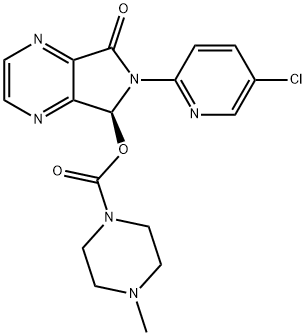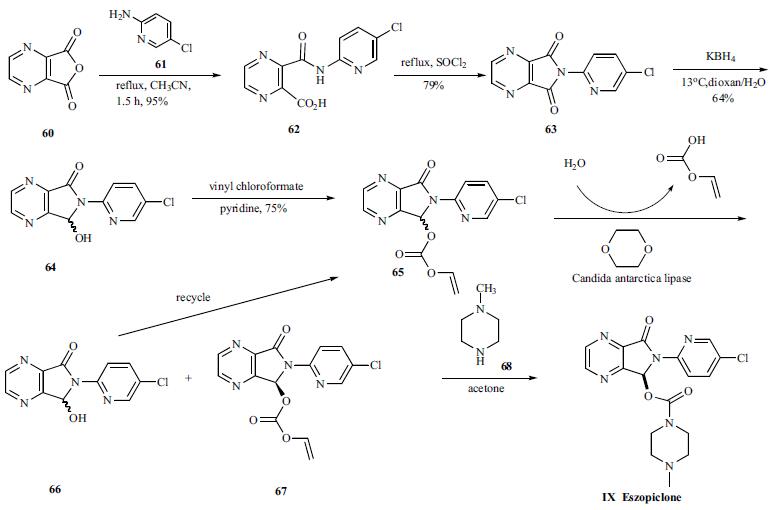|
ChemicalBook Optimization Suppliers |
| 名前: |
LGM Pharma |
| 電話番号: |
1-(800)-881-8210 |
| 電子メール: |
inquiries@lgmpharma.com |
|
| 化学名: | エスゾピクロン | | 英語化学名: | Eszopiclone | | 别名: | ESOPICLONE;ESZOPICLONE;(S)-(+)-ZOPICLONE;[(9S)-8-(5-Chloropyridin-2-yl)-7-oxo-2,5,8-triazabicyclo[4.3.0]nona-1,3,5-trien-9-yl]4-methylpiperazine-1-carboxylate;Lunesta;ESZOPICLONE CIV;1-Piperazinecarboxylic acid, 4-methyl-, (5S)-6-(5-chloro-2-pyridinyl)-6,7-dihydro-7-oxo-5H-pyrrolo[3,4-b]pyrazin-5-yl ester (9CI);1-Piperazinecarboxylic acid, 4-methyl-, 6-(5-chloro-2-pyridinyl)-6,7-dihydro-7-oxo-5H-pyrrolo[3,4-b]pyrazin-5-yl ester, (S)- | | CAS番号: | 138729-47-2 | | 分子式: | C17H17ClN6O3 | | 分子量: | 388.81 | | EINECS: | 202-303-5 | | カテゴリ情報: | GABA/Glycine receptor;Intermediates & Fine Chemicals;Pharmaceuticals;Sedative, Hypnotic | | Mol File: | 138729-47-2.mol |  |
| 融点 | 202-204°C | | 比旋光度 | D20 +135 ±3° (c = 1.0 in acetone) | | 沸点 | 580.7±50.0 °C(Predicted) | | 比重(密度) | 1.54±0.1 g/cm3(Predicted) | | 貯蔵温度 | -20°C Freezer | | 溶解性 | Chloroform (Slightly, Heated), Methanol (Slightly, Heated) | | 外見 | Solid | | 酸解離定数(Pka) | 6.70±0.10(Predicted) | | 色 | White to Light Beige | | InChI | InChI=1S/C17H17ClN6O3/c1-22-6-8-23(9-7-22)17(26)27-16-14-13(19-4-5-20-14)15(25)24(16)12-3-2-11(18)10-21-12/h2-5,10,16H,6-9H2,1H3/t16-/m0/s1 | | InChIKey | GBBSUAFBMRNDJC-INIZCTEOSA-N | | SMILES | N1(C(O[C@H]2C3=NC=CN=C3C(=O)N2C2=NC=C(Cl)C=C2)=O)CCN(C)CC1 | | CAS データベース | 138729-47-2(CAS DataBase Reference) |
| | エスゾピクロン Usage And Synthesis |
| 効能 | 催眠鎮静薬 | | 商品名 | ルネスタ (エーザイ) | | 説明 | Eszopiclone is a non-benzodiazepine hypnotic agent indicated for the treatment of
insomnia to induce sleep and for sleep maintenance. It has similar pharmacokinetic
and pharmacodynamic parameters as the previously marketed non-benzodiazepine
hypnotics zolpidem and zaleplon. However, unlike its predecessors, eszopiclone is
not restricted to short-term treatment of insomnia. Clinical studies of up to 6
months of use show that patients do not develop tolerance to its effect. Eszopiclone
is the (S)-enantiomer of zopiclone, which has been marketed as the racemic mixture
in Europe for almost 20 years. These agents belong to the cyclopyrrolone class of
drugs that act as agonists at the type A GABA receptor. Eszopiclone has approximately
50-fold higher binding affinity than its antipode (R)-zopiclone for GABA-A
receptor (IC50=21 and 1130 nM, respectively). In addition, the two enantiomers
exhibit significant differences in their pharmacokinetic parameters and in vivo efficacy.
In healthy volunteers, eszopiclone has 2-fold higher Cmax and 2-fold greater
elimination half-life than the (R)-enantiomer.The two most frequent adverse events associated with eszopiclone
treatment are unpleasant taste and headache. Other less frequent side effects include
somnolence, dry mouth, and nausea. | | 化学的特性 | White To Pale Yellow | | Originator | Aventis (France) | | 使用 | Eszopiclone is the active stereoizomer of Zopiclone and belongs to the class of drug known as cyclopyrrones. It is a nonbenzodiazepine hypnotic agent used as a treatment for insomnia.
This is a controlled substance (depressant) in the US but not in Canada. | | 定義 | ChEBI: The (5S)- (active) enantiomer of zopiclone. Unlike almost all other hypnotic sedatives, which are approved only for the relief of short-term (6-8 weeks) insomnia, eszopiclone is approved by the U.S. Food and Drug Administration for long-te
m use. | | brand name | (Pharmacia & Upjohn); Ortho-EST (Sun)Lunesta (Sepracor). | | 作用機序 | The cyclopyrrole zopiclone is described as a “superagonist” at BZRs with the subunit composition α1β2γ2 and
α1β2γ3, because it potentiates the GABA-gated current more than the benzodiazepine (flunitrazepam) reference
agonist. Racemic zopiclone has been available in Europe since 199,2 and the higher affinity S-enantiomer
(eszopiclone) was marketed in the United States in 2005, primarily to treat insomnia, because of its rapid onset and
moderate duration (half-life, ~6 hours) of hypnotic-sedative effect. Less than 10% of orally administered
eszopiclone is excreted unchanged, because it undergoes extensive CYP3A4- and CYP2E1-catalyzed oxidation and
demethylation to metabolites excreted primarily in urine.
" | | 薬物動態学 | Zoplicone was originally marketed as a racemic mixture; however, because the sedative activity is primarily
associated with the S-isomer, only the S-isomer is currently marketed in the United States (as esozoplicone)
(36). It is soluble in dilute mineral acids. Unlike zolpidem and zaleplon, eszoplicone is not as specific for the α1
subunit of GABAA, but it binds broadly, like the benzodiazepines (Table 19.2). Its pharmacological and
pharmacodynamic activities, however, are more closely related to those of the nonbenzodiazepines. It is
rapidly absorbed, with an oral bioavailability of approximately 80%, reaching peak concentrations in 1 h and
having a relatively long elimination half-life of approximately 6 hours (Table 19.2). Eszopliclone is primarily
metabolized to (S)-zoplicone N-oxide and (S)-N-desmethylzoplicone by the CYP3A4. (S)-N�desmethylzopiclone binds to GABA receptors with substantially lower potency than eszopiclone, and
(S)-zopiclone-N-oxide shows no significant binding to this receptor. It does not accumulate with once-daily
administration, and it exhibits linear (dose-proportional) pharmacokinetics over the range of 1 to 6 mg.
Eszopiclone is weakly bound to plasma protein (52–60%), suggesting that eszopiclone distribution should not
be affected by drug–drug interactions caused by protein binding. Up to 75% of an oral dose of racemic
zopiclone is excreted in the urine, primarily as metabolites. A similar excretion profile would be expected for eszopiclone. Less than 10% of the orally administered eszopiclone dose is
excreted in the urine as unchanged drug. After a high-fat meal, peak plasma concentrations can be delayed by
approximately 1 hour without affecting its half-life. | | 合成 | The synthesis of eszopicolone involves enzymatic resolution
of a zopicolone derivative to give the chiral compound
as depicted in the Scheme 12. Pyrazine-2,3-
dicarboxylic acid anhydride was reacted with 2-amino-
5-chloropyridine (61) in refluxing acetonitrile to generate 3-
(5-chloro-2-pyridyl)carbamoyl pyrazine-2-carboxylic acid
(62) in 95% yield. Compound 62 was cyclized by treating
with refluxing SOCl2 to give 6-(5-chloropyrid-2-yl)-5,7-
dioxo-5,6-dihydropyrrolo[3,4-b]pyrazine (63) in 79% yield.Compound 63 was subjected to partial reduction with KBH4
in dioxane-water at low temperature to give 6-(5-chloro-2-
pyridyl)-7-hydroxy-5,6-dihydropyrrolo[3,4-b]pyrazin-5-one
(64) in 64% yield, which was esterified with vinyl chloroformate
in pyridine to give corresponding vinyl acetate 65 in
75% yield. The racemic 65 was then subjected to kinetic
resolution by a highly enantioselective enzymatic hydrolysis
process. Chiral vinyl acetate 67 with desired stereochemistry
was obtained when candida antarctica lipase was employed
for hydrolysis of 65 in dioxane/water at 60oC for 2 days.
Interestingly, the enzymatic hydrolysis stopped at 50% conversion
and the hydrolyzed alcohol was recovered as the
starting substrate 65 because of spontaneous racemization of
the alcohol in the reaction medium. Therefore, although a
maximum yield of kinetic resolution is 50%, the overall efficiency
of this enzymatic process is 100% because of substrate
recycling. Finally, the chiral vinyl acetate 67 was condensed
with methyl piperazine in acetone to give eszopicolone
(IX). 
| | 代謝 | The effects of eszoplicone on sleep onset may be reduced if
it is taken either with or immediately after a high-fat/heavy meal. In elderly subjects, the elimination half-life
was prolonged to approximately 5 to 9 hours. Therefore, in elderly patients, the starting dose should be
decreased to 1 mg, and the dose should not exceed 2 mg. No dose adjustment is necessary in patients with
renal impairment, because less than 10% of the orally administered eszopiclone dose is excreted in the urine as
parent drug. Although no pharmacokinetic or pharmacodynamic or drug interactions have been reported for
eszopiclone, potent inhibitors of CYP3A4 could increase plasma levels of eszopiclone. Eszopiclone does not
alter the clearance of drugs metabolized by common CYP450 enzymes. Potential pharmacodynamic interactions (additive pharmacological effects) with CNS depressants such as alcohol, anticonvulsants, antihistamines,
antidepressants, or other psychotropic drugs could occur. Dosage adjustment may be necessary when
eszopiclone is administered with CNS depressants; concomitant use with alcohol should be avoided.
The primary advantage of eszoplicone is that it has been shown to be effective in chronic insomnia (long-term
treatment) in measures of sleep latency, total sleep time, and wake time after sleep onset without development
of tolerance. Eszoplicone would appear to be most effectively used for patients who tend to awaken during
the night rather than patients for whom the primary problem is initiating sleep. |
|